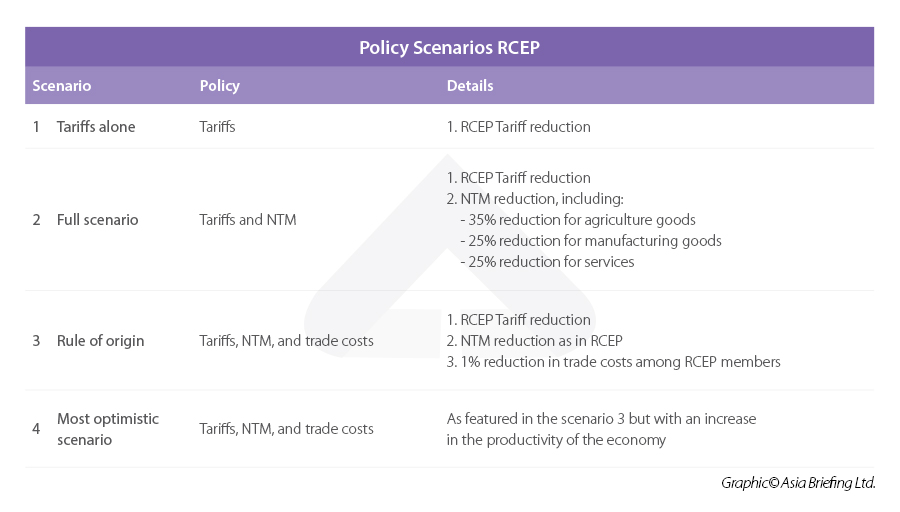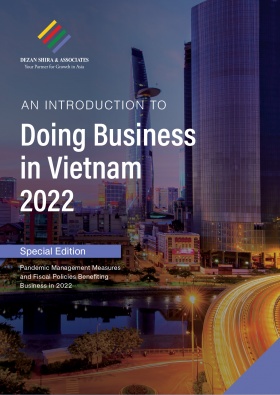Vietnam’s Economy to Benefit Most from RCEP: World Bank
A recent report from the World Bank offers a thorough analysis of how the RCEP can impact the economic atmosphere of its country members, including Vietnam. Here, Vietnam Briefing highlights the facts and statistics on why and how Vietnam, among other middle-income countries, could benefit the most from the RCEP.
The Regional Comprehensive Economic Partnership (RCEP) agreement officially took effect on January 1, 2022. The countries that belong to RCEP account for almost one-third of world GDP and world population, and one-quarter of world exports and imports. If implemented successfully, it can have a considerable impact on not only Vietnam but the world’s economy.
The World Bank Report
The World Bank’s (WB) white paper Estimating the Economic and Distribution Impacts of the Regional Comprehensive Economic Partnership constructed a baseline or starting point and four alternative scenarios to estimate the economic and distributional impacts of the RCEP in Vietnam. The baseline reflects the business-as-usual conditions prior to the implementation of the RCEP, where the tariffs of previous agreements, including the Comprehensive and Progressive Agreement for Trans-Pacific Partnership (CPTPP), have been implemented, in parallel with the US-China trade war.
Then, the four alternative policy scenarios, as elaborated below, are compared against this baseline to determine the effect of the RCEP on Vietnam’s economy.
The four alternative policy scenarios take the effect of different policies into consideration to measure the impact of the RCEP. These policies can range from tariffs, and non-tariff measurements (NTMs) to trade cost policies.
As per UNCTAD, NTMs are policy measures, different from ordinary customs tariffs, that can potentially have an economic effect on international trade in goods. Technical requirements, export subsidies, minimum import prices, and environmental and health compliance requirements are some examples of NTMs.
Macroeconomic impact
In the baseline, between 2020 and 2035, the average tariffs imposed by Vietnam decline from 0.8 percent to 0.2 percent, while the tariffs faced by Vietnam are reduced from 0.6 percent to 0.1 percent.
In the most optimistic scenario (scenario 4), where all benefits are applied, Vietnam has the highest gains of all RCEP member countries. Vietnam’s income levels increase by 4.9 percent relative to the baseline, higher than other countries, where the income level increases by 2.5 percent.
While exports and imports increase for all RCEP member countries, Vietnam is expected to experience the highest increase in exports at 11.4 percent. Similarly, Vietnam’s imports also grow significantly at 9.2 percent compared to 7.2 percent for the Philippines.
Of that, the motor vehicle sector expands the most for Vietnam at 18.6 percent, followed by textiles at 16.2 percent, and apparel at 14.9 percent, mainly due to reductions in non-tariff measures.
In the scenario where only the tariff reduction is implemented (scenario 1), the impact on Vietnam’s economy is negligible, with the income level increase close to zero. Trade also sees a small reduction relative to the baseline, with exports and imports declining by 0.3 percent. This is because Vietnam has already enjoyed relatively low tariffs thanks to other free trade agreements that Vietnam participates in.
Impact on industries
The RCEP offers an opportunity to boost growth and support recovery from the COVID-19 pandemic. Vietnam and Malaysia are the countries that expect to make the highest gains as per the World Bank. The RCEP would also help Vietnam access large consumer markets double the size of those included in the CPTPP, including China, South Korea, and Japan.
At the same time, however, the RCEP poses some inevitable challenges for Vietnam as it has to raise its standard to keep up with higher demand and intense competition.
Electrical equipment and machinery
As per the WB’s report, electrical equipment and machinery is expected to expand the most for Vietnam at 12.1 percent. Thanks to reduced tariffs as well as positive policies regarding rules of origin, exports for this sector will grow significantly. Destination for Vietnam’s electrical equipment and machinery exports is expected to come mostly come from within RCEP member countries.
Textiles and apparel
Textiles and apparel come next as the second-largest expansion at 9 percent. The expansion of textiles is largely due to the higher demand from within RCEP member countries whereas apparel enjoys increasing demand globally.
Wood and paper products
Vietnam is forecast to import more wood and paper products from other non-RCEP countries while the export level of these products is currently negligible. Subsequently, the industry is expected to observe a reduction in production with a 0.5 percent decline.
Pharmaceuticals
Similarly, the pharmaceutical industry is expected to expand less due to strong competition with other markets like India and China. The industry also suffers from less beneficial non-tariff measures as well as limited input as the country’s pharmaceutical industry is heavily dependent on India and China for input supply. As per the WB, the sector will expect a decline in growth of 1.6 percent relative to the baseline.
Socio-economic implications
Higher wages for women
Driven by strong economic resilience and sustained growth in the RCEP region, particularly in Vietnam and China, extreme poverty under the baseline scenario is expected to decline from 0.98 percent in 2020 to 0.12 percent by 2035.
Thus, the RCEP will also bring about more equality in the job market. By creating job opportunities in sectors of the economy that employ a larger share of women, such as textiles, apparel, electronics, and several service sectors, wages for women will be rising faster than wages for male workers, particularly in Vietnam.
Wages for the country would grow annually by 0.76 and 0.67 percentage points above the baseline for females and males, compared to regional neighbors like the Philippines, where wages are expected to grow annually by 0.13 and 0.11 percentage points for females and males, respectively.
Further growing middle class
Half of the population in the RCEP, or 1.1 billion people, contributes the equivalent of US$10 a day or more in purchasing power terms. If successfully functioning, the partnership could draw as many as 27 million more people into the middle class for all member countries by 2035.
Of that, Vietnam will expect the largest gains with 1.7 million more people entering the middle class, and wages growing the fastest of all RCEP members, both for male and female workers. And this signals a significant potential for consumer goods and services such as food & beverages, entertainment, lifestyle products, and services, especially in major cities like Ho Chi Minh City and Hanoi.
SME benefits
In addition, the simplification of procedures such as customs and rules of origin will help reduce bureaucracy allowing more small and medium-sized enterprises (SMEs) to participate. SMEs account for 98 percent of all enterprises in Vietnam, contributing to 40 percent of GDP, and thus the RCEP presents significant opportunities for Vietnamese SMEs to move up the value chain.
Rules of origin
RCEP benefits may appear modest for Vietnam when compared to the CPTPP or the EVFTA.
Nevertheless, the benefits are likely to increase significantly if the country successfully reduces tariffs and NTMs and makes use of rules of origin.
Additionally, rules of origin can make exports less dependent on imported goods while encouraging member countries to operate more on regional supply chains. With the implementation of rules of origin in addition to tariff reductions and NTMs, total exports from RCEP members could grow by 5.2 percent on average.
As member countries integrate further into the regional supply chains, RCEP members could also benefit from less expensive imported goods.
Challenges
Nevertheless, analysts have also noted that once the RCEP takes effect, Vietnamese businesses would face competition both domestically and in export markets as well.
Further, the government also has to take careful notice of the costs associated with the RCEP. This may include the costs of lowering non-tariff barriers and the transitional costs associated with trade-related structural changes such as employment changes.
Considering these factors will help create an environment where exporters can take full advantage of the common rules of origin without inviting high costs.
Takeaways
Currently, trade within RCEP countries represents only 20 percent of the total trade of RCEP member states, so there is considerable potential for increasing trade flows within the region to boost growth.
In addition, investors looking to take advantage of manufacturing in Asia should study the FTA text carefully to learn about the advantages. Manufacturers in more advanced countries such as China, South Korea, and Japan can look at how to minimize costs by outsourcing final processing to less-developed ASEAN countries to benefit.
For Vietnam, as the country already participates in other FTAs in the region, most gains do not come from the reduction of already low levels of tariffs. Rather, the country’s economic growth will come from deeper and more comprehensive commitment via intra-RCEP trading, common rules of origin, and greater openness in goods and services through improved markets, especially in China.
About Us
Vietnam Briefing is produced by Dezan Shira & Associates. The firm assists foreign investors throughout Asia from offices across the world, including in Hanoi, Ho Chi Minh City, and Da Nang. Readers may write to vietnam@dezshira.com for more support on doing business in Vietnam.
We also maintain offices or have alliance partners assisting foreign investors in Indonesia, India, Singapore, The Philippines, Malaysia, Thailand, Italy, Germany, and the United States, in addition to practices in Bangladesh and Russia.
- Previous Article Ключевые соображения при выборе промышленной зоны во Вьетнаме
- Next Article Parchi industriali del Vietnam: Scegliere la posizione giusta per il tuo investimento








